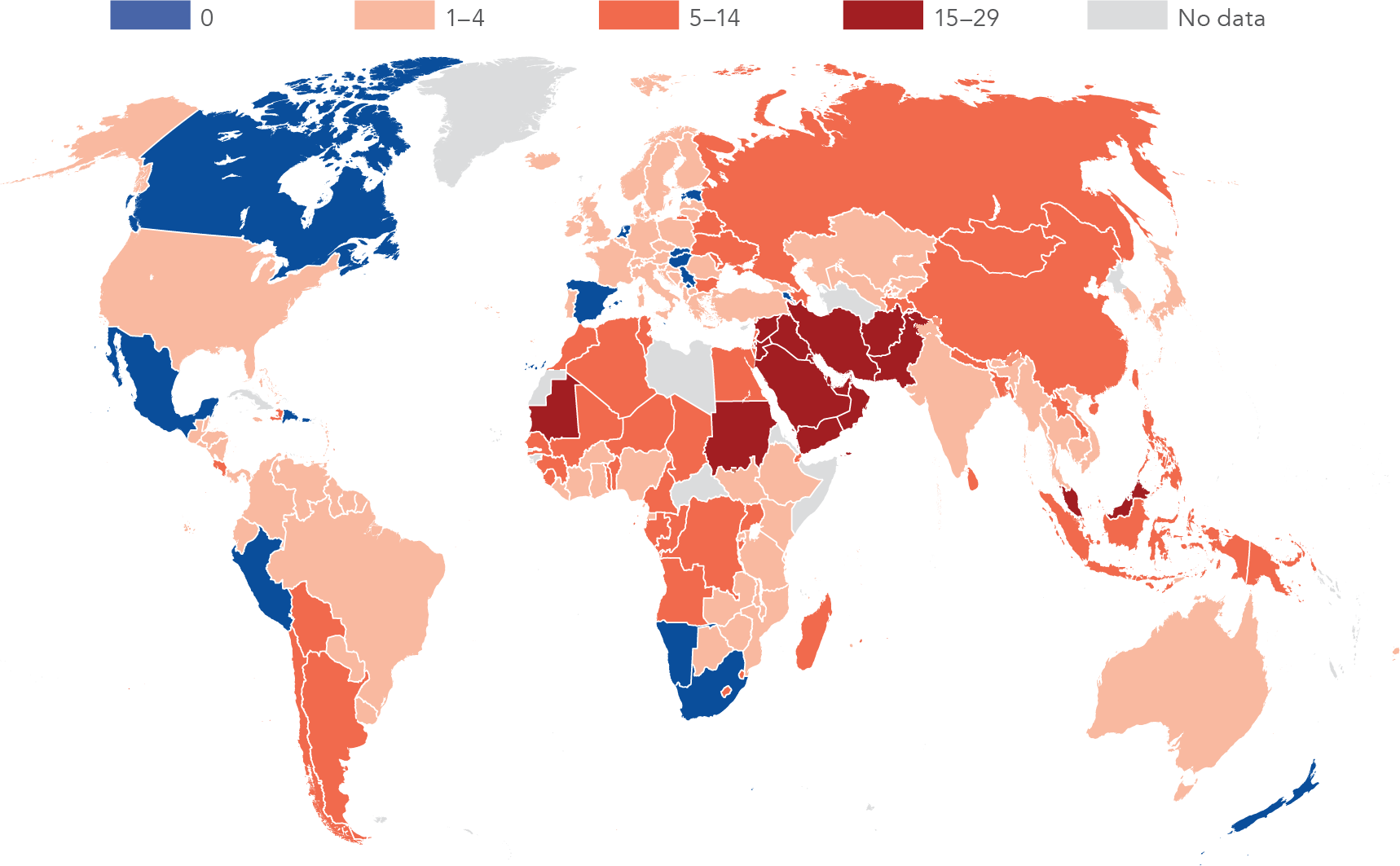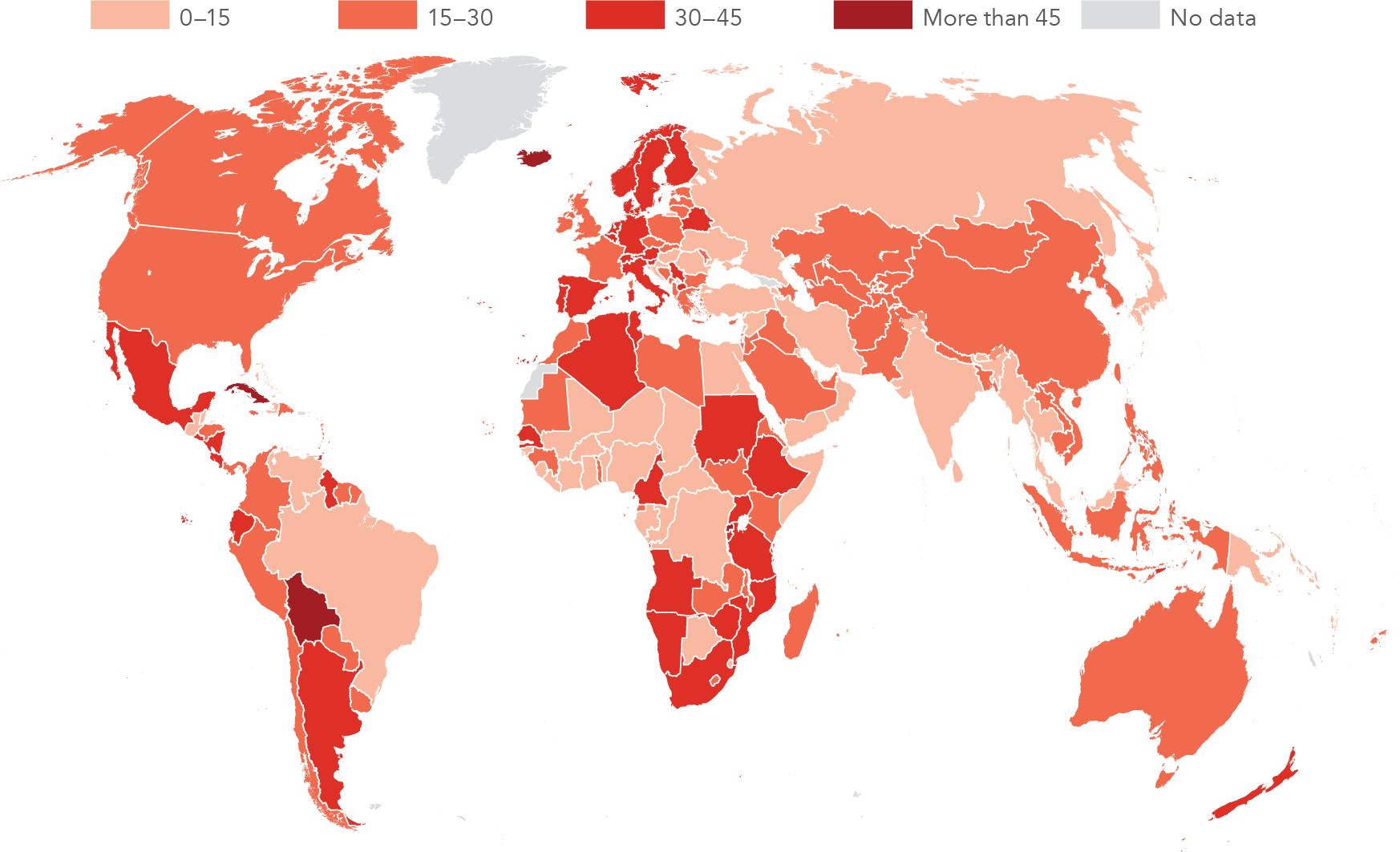Ending legal gender differences
Ending all forms of discrimination against women and girls is crucial for inclusive sustainable development (target 5.1). Widespread legal gender differences affect women's economic prospects—for example, by making it difficult for women to own property, open bank accounts, start businesses, and enter certain professions. Countries in the Middle East and North Africa have on average 16 laws relating to employment and entrepreneurship that differentiate between women and men, while countries in South Asia average 8, and those in Sub-Saharan Africa average 6 (figure 5a).1,2 In East Asia and Pacific, the average number of legal gender differences is 5, followed by Europe and Central Asia with 3, Latin America and the Caribbean with 2, and North America with 1.
Combating harmful social norms
Despite the existence of violence against women across the globe, specific laws against gender-based violence are not universal (target 5.2). In 49 countries there is no specific law against domestic violence, in 45 there is no legislation to address sexual harassment, and 112 countries do not criminalize marital rape. And in many countries societal norms permit physical and verbal abuse—for instance, if a wife argues with her husband or partner, refuses to have sex, burns food, goes out without telling him, or neglects the children (figure 5b). In Timor-Leste and Central African Republic, for example, the law penalizes domestic violence, sexual harassment and marital rape, but around 80 percent of women still justify spousal abuse in any of the five circumstances listed. While recent laws to address gender-based violence signal progress over the past couple of years, social norms against wider gender equality reduce the potential for change.
Breaking the cycle of early marriage and poverty
A woman's access to education and later her employment opportunities as well as the nature and terms of her work are often compromised by early marriage: Goal 5 looks to eliminate this practice (target 5.3). Young married girls whose schooling is cut short often lack the knowledge and skills for formal work and are limited to occupations with lower incomes and inferior working conditions (figure 5c). Early marriage is widespread in parts of South Asia, Sub-Saharan Africa, the Middle East and North Africa, and Latin America and the Caribbean. Even though Niger, Chad, Central African Republic, and Mali legally prohibit child marriage, and there are penalties for authorizing or knowingly entering into early marriage, more than half of all girls are married by age 18.3
Promoting shared responsibility for unpaid work
Women typically spend disproportionately more time on unpaid domestic and care work than men. Goal 5 seeks recognition of this work and a more equitable distribution of these activities between women and men (target 5.4). Of the countries surveyed, women spend on average between 13 (Thailand) and 28 percent (Mexico) of their time in unpaid domestic and care activities, while men spend between 3 (Japan) and 13 percent (Sweden) (figure 5d).4 This unequal division of responsibilities is correlated with gender differences in economic opportunities, including low female labor force participation, occupational sex segregation, and earnings differentials.
Enhancing women's use of technology
Technology can contribute to women's empowerment by helping them overcome mobility constraints, access relevant information and new communication channels, and participate in existing networks (target 5.b).
Widespread differences between men and women in access to basic technology persist in most parts of the world (figure 5e). Overall, women are less likely to be Internet users regardless of their region or income. The difference in Internet use can be as high as 20 percentage points (Turkey). Only one-fifth of countries with data have no evidence of a difference.5
Technology also presents an opportunity to increase financial inclusion. While only 2.5 percent of men and 1.6 percent of women worldwide have a mobile money account, 12.8 percent of men and 10.3 percent of women in Sub-Saharan Africa have one. Although financial inclusion starts with having a bank account, only with regular use do people benefit from it. Around 40 percent of wage recipients in low- and middle-income countries report receiving their wage payments into an account, and large gender gaps remain. Women in low- and middle-income countries are about a third less likely than men to report having received any wage payments into an account in the previous year.4
Expanding female participation in nontraditional areas
Teaching both women and men the technical skills and capabilities to succeed in the digital economy is a top priority. Across the world, women are overrepresented in education and health; equally represented in social sciences, business, and law; and underrepresented in engineering, manufacturing, construction, and science (figure 5f). This sharp divergence does not reflect the capabilities of men and women in different subjects. Driving this segregation are gender biases at school and at home, limited exposure of girls to science and technology at an early age, and a lack of opportunities to enroll in such programs. Early exposure can shift stereotypes that discourage girls from participating in science and technology fields, with implications for their occupational choices and earning potential.
Increasing women's representation in parliaments
Goal 5 strives for the full participation of women at all levels of decisionmaking in political, economic, and public life (target 5.5). Across the globe women occupy, on average, 23 percent of parliamentary seats in 2016, up from 12 percent in 1997. Women made up nearly 29 percent of seats in Latin America and the Caribbean and 26 percent in Europe and Central Asia. Despite a fourfold increase in the share of women parliamentarians in the Middle East and North Africa since 1997, the region still had the lowest proportion of women-held seats, at 17 percent. In 2016, only two countries had 50 percent or more women in parliament: Rwanda, with nearly 64 percent, and Bolivia, with 53 percent. In contrast, seven countries had no women in parliament: Yemen, Vanuatu, Tonga, Qatar, Palau, Micronesia, and Haiti (figure 5g).
Notes
- Women, Business, and the Law examines 21 differences in policies for unmarried women and 26 for married women (or 47 questions in the database) that affect women's economic opportunities.
-
The measure of legal gender differences can sum to a whole number or a decimal for any economy because the question on job restrictions has 10 subquestions that examine specific restrictions on women's work. Each subquestion thus has a value of one-tenth. Values presented here are rounded to the nearest whole number.
-
The legal age of marriage for boys and girls is 21 years in Niger and Chad, and 18 in the Central African Republic. In Mali, the legal age is 18 years for boys and 16 years for girls.
-
Demirguc-Kunt, A., L. Klapper, D. Singer, and P. Van Oudheusden. 2015. "The Global Findex Database 2014: Measuring Financial Inclusion around the World". Policy Research Working Paper 7255. World Bank, Washington, DC. Each economy is classified based on the classification of World Bank Group's fiscal year 2015 (July 1, 2014–June 30, 2015).
-
There is no evidence of a gap when the difference in the use of Internet between men and women is ±1 percentage point.



